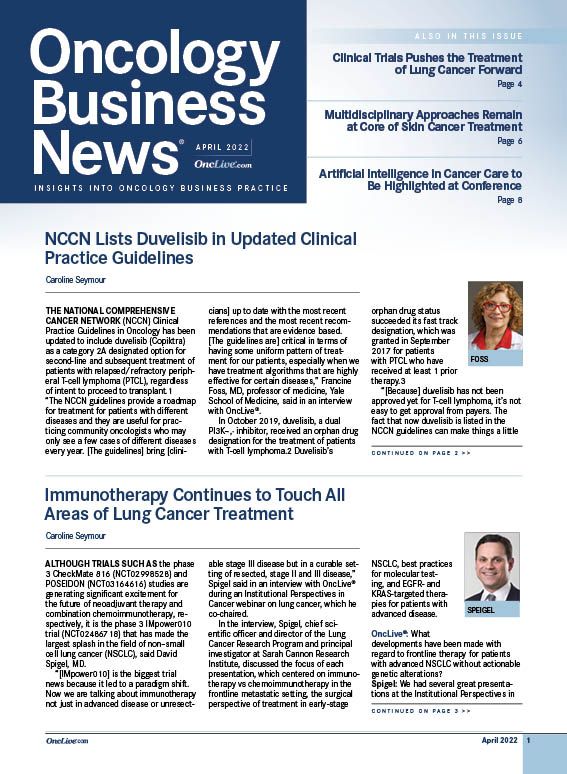Publication
Article
Systemic Advances Shine, But Multidisciplinary Approaches Remain at Core of Skin Cancer Treatment
Author(s):
Jason Luke, MD, FACP, reviews key points from each presentation from an Institutional Perspectives in Cancer webinar on melanoma and provides perspective on the practice-changing benefits of therapies moving into earlier lines of treatment.
Jason Luke, MD, FACP

The skin cancer treatment landscape is evolving, with several new standards of care being introduced, including immunotherapy for basal cell carcinoma and checkpoint inhibitors such as the fixed-dose combination nivolumab plus relatlimab (Opdualag), explained Jason Luke, MD, FACP, who also emphasized the potential groundbreaking approval of tumor-infiltrating lymphocyte (TIL) therapy.
Although studies on these approaches have centered around skin cancer, they are opening the door for treatment in other tumor types, Luke added.
“It’s very exciting to think about how [melanoma drug approvals] may be able to benefit more patients in the future of different cancer types,” Luke said in an interview with OncLive® following an Institutional Perspectives in Cancer webinar on melanoma, which he chaired.
In the interview, Luke, associate professor of medicine, director, Cancer Immunotherapeutics Center, Immunology and Immunotherapy Program, University of Pittsburgh Medical Center (UPMC) Hillman Cancer Center, reviewed key points from each presentation from the meeting and provided perspective on the practice-changing benefits of therapies moving into earlier lines of treatment. Luke also emphasized the importance of a multidisciplinary, team-based approach in all stages of disease to provide quality patient care and support innovative treatment combinations.
OncLive®: Starting with your presentation on basal cell carcinoma, what is important to know about the evolving treatment landscape in this space?
Luke: Basal cell carcinoma is an evolving space. We have had the use of hedgehog inhibitors for approximately the past 10 years. Hedgehog inhibitors are highly effective targeted therapies, albeit with a disadvantageous toxicity profile, such that more than half of patients end up stopping them because of adverse effects [AEs].
More recently, it’s very exciting that we’ve had an approval of the PD-1 inhibitor cemiplimab-rwlc [Libtayo] as the first immunotherapy [agent] for basal cell carcinoma. That’s a very attractive option, and the label is for patients who have progressed or were intolerant to hedgehog inhibitors. [That approval] is exciting because we know that many patients can benefit with durable control of their disease with immunotherapy.
All of this then sets up a future [question]: What about combinations of hedgehog inhibitors with immunotherapy? Those are the clinical trials that I emphasized at the end of my talk, which are likely to get going within the next year or so.
Could you elaborate on some of those clinical trials that could be coming our way?
Clinical trials in basal cell carcinoma are really [in] two flavors right now. One is trying to optimize the use of hedgehog inhibitors [by evaluating] pulsatile dosing, sort of an on-off kind of an approach.
The other exciting approach would be the development of hedgehog inhibitors that are less toxic with or without anti–PD-1 immunotherapy. I’ve been working with a company called Endeavor [Biomedicines], which is developing a potential best-in-class hedgehog inhibitor called taladegib in PTCH1-mutant tumors, which would include basal cell carcinoma. We’re also going to pursue a clinical trial combining that agent with anti–PD-1 immunotherapy, hoping to leverage the benefit of targeted inhibition of the hedgehog pathway along with the immunotherapy for long-term benefit.
Turning to the presentation given by John Kirkwood, MD, of UPMC Hillman Cancer Center, which focused on metastatic melanoma as the poster child for immunotherapy, have we seen the role of checkpoint inhibition grow within the advanced setting?
In the past couple of years, we’ve realized that the backbone of therapy for metastatic melanoma is immune checkpoint blockade, and several studies have shown this.
One study that has emphasized this is the DREAMseq trial [NCT02224781], which randomized patients to receive BRAF and MEK inhibition or [ipilimumab (Yervoy) and nivolumab (Opdivo)] as their first option. At the 2-year landmark, we observed a massive benefit to the [ipilimumab and nivolumab] combination such that the standard of care for metastatic melanoma really should be [a] checkpoint inhibitor and not BRAF inhibition in the frontline setting.
Also, we now have a third checkpoint inhibitor approved for melanoma. The combination of nivolumab and relatlimab received FDA approval [in March 2022], and that combination looks to be at least as potent as the combination of [ipilimumab and nivolumab], but with a much improved AE profile.
We’re entering a space where the frontline treatment of metastatic melanoma should be dual checkpoint blockade. For many patients, that can be nivolumab and relatlimab as a high-benefit, low-toxicity [treatment].
I still plan to use [ipilimumab and nivolumab] in those patients who have very high-risk disease like brain metastases or liver metastases and high [lactate dehydrogenase (LDH)] because we have that long-term experience of knowing that [this regimen] can be an effective therapy for those patient populations.
What are your thoughts on the approval of relatlimab and nivolumab?
The approval of relatlimab in melanoma is a landscape shift for all of cancer. It shouldn’t be underappreciated how big a deal this is. Essentially for anywhere that [anti–]PD-1 was approved previously, it makes sense to add relatlimab.
In melanoma, that’s going to be in the frontline setting, but it also sets up the potential for triplets in melanoma. Therefore, what about [anti–]PD-1, LAG-3, and CTLA-4 inhibition?
Even in other diseases where immunotherapy is combined with chemotherapy, say, lung cancer, where we gave pembrolizumab [Keytruda] plus chemotherapy, now, should we consider giving PD-1 and LAG-3 inhibitors with chemotherapy? That’s the kind of effect this approval is going to have.
Looking at the presentation given by Diwakar Davar, MD, of UPMC Hillman Cancer Center, which centered on novel approaches for relapsed/refractory melanoma, how does the choice of frontline therapy affect subsequent treatment options for patients who progress?
In melanoma, we have an emerging landscape of treatment options for our patients, so the choice of first-line therapy can really dictate what happens afterwards.
There’s been an argument about PD-1 inhibition alone vs the combination of PD-1 and CTLA-4 inhibition. It’s important to point out that the combination has a fair amount of activity even in the [anti–]PD-1 refractory space. If your patient was to get [an anti–]PD-1 monotherapy for melanoma and progress, you can get about a 30% response rate by adding ipilimumab and continuing anti–PD-1.
More broadly, there’s a whole host of developmental therapeutics that are in the pipeline now. If a patient progresses, please seek out clinical trials because there are many options that are on the horizon that may come into standard practice over the next year or so.
The last presentation, given by Yana Najjar, MD, of UPMC Hillman Cancer Center, centered on cutaneous squamous cell carcinoma. What sort of multidisciplinary management is required within this disease?
The management of advanced squamous cell carcinoma requires an integrated multidisciplinary team. The disease most commonly is locally aggressive, and therefore we need help from our surgeons to manage that, but also radiation therapy to consolidate those surgeries, and possibly even to try to control refractory tumors.
That being said, [there’s] really been a breakthrough with the development of PD-1 inhibitors in cutaneous squamous cell carcinoma, with response rates [of] more than 50%. Thinking about how and when to integrate surgery, radiation, and PD-1 inhibition [from] medical oncology is at the core of [our] management for every patient. Team therapy is the most important approach.
What forward-looking research across these diseases are you looking forward to seeing more of?
Since all skin cancers are, generally speaking, responsive to PD-1 inhibitors, we see fairly consistent themes of combining checkpoint inhibitors to try to augment response, but also to try to overcome resistance with therapies like intratumoral therapies, TLR9 [agonists] or oncolytic viruses being very obvious ones. There are also emerging data for small-molecule VEGF kinase inhibitors like lenvatinib [Lenvima] and others in combination with PD-1 inhibitors.
Finally, TILs, especially in melanoma, is a therapy that has been a historical legacy of our field, but [one that] is getting close to FDA approval. It’s entirely possible that within the confines of 2022 there could be an FDA approval for TIL therapy, which really would be a ground shift in our landscape of therapeutics. Similar approaches are going to be thought about across all the cutaneous malignancies.
A key take-home, thinking about cutaneous malignancies, is the team-based oncology approach. That really goes from early-stage disease all the way through refractory metastatic disease because our therapies are moving into earlier lines of therapy. We have neoadjuvant presurgical trials, we have stage II approvals in melanoma, and obviously in stage III and in metastatic disease.
We really need input from dermatologists, surgeons, sometimes our radiation oncology colleagues, and obviously medical oncology, to help guide all of this. Don’t lose sight of that. Get your colleagues involved early and keep them involved throughout the patient’s care.










